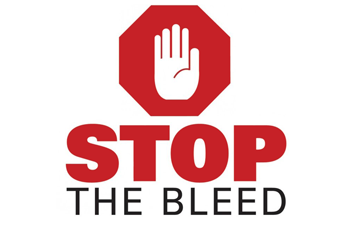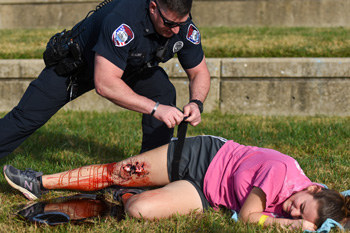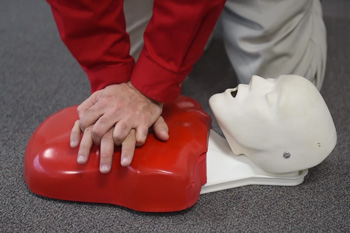Stop the Bleed: Bleeding Control for the Injured
- Get Prepared
- Emergencies
- Current: Stop the Bleed
National Stop the Bleed Day is May 22, 2025


Stop the Bleed is a national campaign launched by the White House in 2015 with two main goals:
- Inform and empower the general public to become trained on basic trauma care in order to stop or slow bleeding during emergencies.
- Increase bystander access to bleeding control kits.
As part of the agency's training and preparedness goals, the Indiana Department of Homeland Security (IDHS) is working to make Bleeding Control Basic courses more readily available throughout Indiana.
Bleeding Control Tips
Quick Tips
- Alert first responders to the situation by calling 911.
- Find the area of bleeding.
- Compress the wound to stop the bleeding.

Action Steps
Bleeding injuries can happen anyplace. Whether you are the one injured and need someone to help you, or you are the person in position to save a life, follow these basic steps to stop the bleeding.
- Call 911: Have someone nearby call 911 while you begin to work on the individual. First responders are trained to control bleeding injuries and can help when they arrive.
- Find the source of the bleeding, and remove clothing over it if it is in the way.
- Focus on the bleeding that is life-threatening.
- Pack or stuff the wound with gauze, a clean cloth, clothing, newspaper or even your hands. Then apply pressure to the wound with both your hands. Keep holding the pressure for at least 5 minutes before checking the wound.
- Add more bandages on top of the existing bandage if blood soaks through.
- If a tourniquet is available, apply it. Tell first responders how long the tourniquet has been in place when they arrive.
- Wash your hands after helping the injured person.

Bleeding Control Courses
Bleeding Control Basic courses, part of the Stop the Bleed initiative, are free, last approximately 90 minutes and can be taken by anyone, including those with little or no medical training. These classes teach basic awareness and understanding for bystanders to recognize and respond to life-threatening bleeding during emergency events such as car accidents, home- or work-related injuries, bombings and mass shootings.
Hoosiers wishing to take a Bleeding Control Basic course should reach out to their local fire department or medical organizations to express interest and receive additional information on course scheduling. IDHS works closely with these organizations to establish training and deliver equipment to those interested in learning these life-saving techniques.
Businesses and Organizations
IDHS partners with local first responders and public safety personnel to administer train-the-trainer classes for qualified individuals wishing to teach the Bleeding Control Basic course. This initiative complements the training and certification programs within the IDHS EMS Division.
Businesses or organizations interested in scheduling a train-the-trainer class should contact the EMS program manager for their district, listed on the EMS Division page.
Resources
Materials
Training Report Form
CPR and AEDs
Knowing what to do in an emergency can save a life, and that is what Emergency Medical Services (EMS) personnel do every day. Paramedics, emergency medical technicians and other first responders work hard to help Hoosiers survive, and the IDHS EMS Division helps train and certifies these professionals.
IDHS even has a mobile simulation laboratory available for public safety agencies to train on using specialized equipment.
First aid skills such as stopping bleeding are invaluable. Visit the EMS How-To Videos page for videos demonstrating how to perform CPR and how to use an AED in the event of a cardiac arrest.

CPR Demonstration
